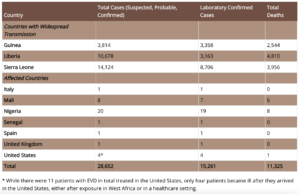Introduction
What is Ebola ?
Ebola is a deadly, but rare, disease in people and nonhuman primates. The viruses that cause Ebola are located mainly in sub-Saharan Africa.
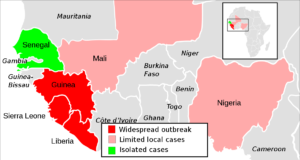 People can get it through physical contact with an infected primate or a sick or dead person infected with Ebola virus.
People can get it through physical contact with an infected primate or a sick or dead person infected with Ebola virus.
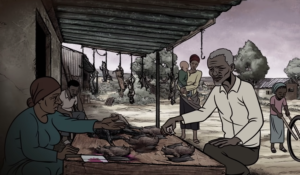
The index patient of Ebola was reported in December 2013 at a small village in Guinea. After five additional cases of fatal diarrhea occurred in that area, an official medical alert was issued on January 24, 2014, to the district health officials. The Ebola virus soon spread to Guinea’s capital city of Conakry, and on March 13, 2014, the Ministry of Health in Guinea issued an alert for an unidentified illness. Shortly after, on March 23, 2014, with 49 confirmed cases and 29 deaths, the WHO officially declared an outbreak of Ebola.
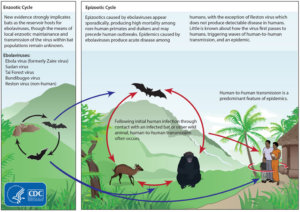 Cases in the United States
Cases in the United States
The index case in US was traveling from West Africa to Dallas, Texas, and died on October 8, 2014. Two healthcare workers who cared for him in Dallas tested positive for Ebola. Both recovered.
Seven other people were cared for in the United States after they were exposed to the virus and became ill while in West Africa, the majority of whom were medical workers. They were transported by chartered aircraft from West Africa to hospitals in the United States. Six of these patients recovered, one died.
Overall, 1 death was reported for Ebola in the United States during the 2014-2016 epidemic; and the total death report for Ebola globally was 11,325.
Ebola fear in the US
The outbreak of Ebola in West Africa in 2014 received a disproportionate amount of media coverage and public attention relative to the threat it posed to public health in the United States.
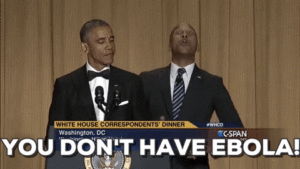
There are two weeks of Wall-to-Wall news coverage with Ebola from CNN, Fox News after one Texas-nurse tests positive.


How Ebola messages diffused on social network?
Information and emotions towards public health issues usually spread widely through online social networks. Health information could be transmitted in a broadcasting fashion, i.e. one-to-many, or a viral spreading fashion which is a chain of individual to individual.
In most cases, when information goes “viral” on social media, it is usually is transmitted in a broadcast fashion on social network.
Case Study on information diffusion
An article studying the structural virality of information diffusion of Ebola fear in United States was published at BMC public health, a peer-reviewed journal about epidemiology of disease and public health.
The researchers reconstructed Ebola-related retweeting paths based on Twitter content and the follower-followee relationships. In addition to describing the diffusion structures, they classify users in the network into four categories (i.e., influential user, hidden influential user, disseminator, common user) based on following and retweeting patterns.

The paper connected the study of structural virality and influential user identification in health message diffusion. They normalized the original measure of structural virality (where 0 being purely broadcast and 1 being purely viral.
Across 192,209 information cascades, the average normalized structural virality is 0.05 (Mdn = 0.0006, SD = 0.12).

The highly skewed distribution indicated that most cascades displayed broadcasting spreading diffusion, whereas only a few displayed viral spreading diffusion, which suggested the existence of a star network of retweets from the original tweet but without any further retweets.

On average, 91% of the retweets were directly retweeted from the initial message. Moreover, 47.5% of the retweeting paths of the original tweets had a depth of 1 (i.e., from the broadcaster). These observations suggested that the broadcasting was more pervasive than viral spreading.
Conclusion
Broadcasting was the dominant mechanism of information diffusion of a major health event on Twitter. And some influential users have more followers than the official public health twitter accounts. Their uncertain credibility sometimes causes unintended panic in the general public. The widespread fear and attention of Ebola among Western news media, social media users, and members of US public despite only one domestic death report, has further demonstrated how information diffusion could lead to catastrophic outcome in the public.
Looking retrospectively now, especially after the COVID-19 pandemic, it might not be a bad idea to be over-prepared or having disproportionally big fear. At least we did not have to go through quarantine back in 2014 when Ebola happened, whereas for the past 2 years, everyone has familiarized themselves with the quarantine protocol in the world. It remains a challenge for the public health officials on how to raise pandemic awareness to the public appropriately without causing unexpected panic to the society.
References
https://www.yahoo.com/entertainment/news/cnn-fox-news-msnbc-wall-wall-ebola-coverage-155800356.html
https://www.cdc.gov/vhf/ebola/history/2014-2016-outbreak/index.html
https://www.youtube.com/watch?v=XCrOdeJYs0&ab_channel=GlobalHealthMediaProject
https://bmcpublichealth.biomedcentral.com/articles/10.1186/s12889-019-6747-8#Fig3
https://bmcpublichealth.biomedcentral.com/articles/10.1186/s12889-020-08697-3
